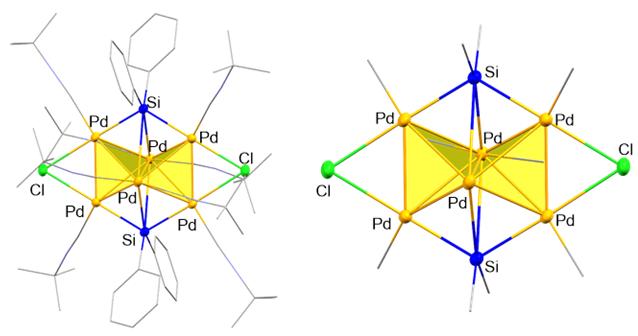'Butterfly-shaped' palladium subnano cluster built in 3-D

The entire (left) and the core (right) structure of 3-D cluster molecule based on palladium. Credit: 2019 Yusuke Sunada, Institute of Industrial Science, The University of Tokyo
Nanochemistry offers a range of classic design shapes, such as cubes, rods, wires, and even “nanoflakes,” all built from atom clusters.
The team at Uni Tokyo's Institute of Industrial Science (IIS) builds nanosheets from the noble metal palladium (Pd). In a new study, they threaded these 2-D building blocks into a distinctive 3-D design.
A smart way to make nanosheets is using templates – organic molecules that act as a framework for the metal atoms. Moving beyond purely organic templates, the IIS team used an organosilicon, a molecule based on three silicon atoms, to construct a bent or “butterfly-shaped” sheet of four Pd atoms. These metals were stabilized by bonding with benzene rings dangling from the silicons.
“Looking at the structure of the Pd4 molecule, we saw the potential to link together multiple sheets of this kind through chemical linkers,” says Kento Shimamoto, co-author of the study in Chemistry – A European Journal. “Given the right template, we reasoned, we could expand the dimensionality of our cluster from a 2-D sheet into the third dimension.”
Building stable nanoclusters, even in 2-D, is not easy – due to the lack of the appropriate template moleclues that pushes the metal species into close proximity.
However, metal centers can be linked stably together, while maintaining a comfortable distance, through the use of bridging atoms like chlorine. The resulting clusters often have unique chemical properties as a result of metal – metal interactions.
The team therefore chose a new organosilicon template with two chlorine atoms replacing part of the organic region. Reacting the palladium source with this new template produced not a 2-D sheet, but a 3-D cluster containing six Pd atoms. The metals apparently formed a pair of Pd4 tetrahedra (sharing two atoms), bridged by chlorine, which forced the Pd atoms close enough to bond with each other.
“3-D subnanoclusters have real potential as catalysts and functional materials,” says lead author Yusuke Sunada. “But their function strongly depends on precise control of their shape. Organosilicons are readily available, and offer a platform for designing diverse architectures – linking multiple clusters into larger molecules – in an industrially feasible way.”
###
“Dimensionality Expansion of Butterfly-shaped Pd4 Framework: Constructing Edge-Sharing Pt6 Tetrahedra,” was published in Chemistry – A European Journal at DOI: 10.1002/chem.201805678.
About Institute of Industrial Science (IIS), the University of Tokyo
Institute of Industrial Science (IIS), the University of Tokyo is one of the largest university-attached research institutes in Japan.
More than 120 research laboratories, each headed by a faculty member, comprise IIS, with more than 1,000 members including approximately 300 staff and 700 students actively engaged in education and research. Our activities cover almost all the areas of engineering disciplines. Since its foundation in 1949, IIS has worked to bridge the huge gaps that exist between academic disciplines and real-world applications.
Media Contact
All latest news from the category: Life Sciences and Chemistry
Articles and reports from the Life Sciences and chemistry area deal with applied and basic research into modern biology, chemistry and human medicine.
Valuable information can be found on a range of life sciences fields including bacteriology, biochemistry, bionics, bioinformatics, biophysics, biotechnology, genetics, geobotany, human biology, marine biology, microbiology, molecular biology, cellular biology, zoology, bioinorganic chemistry, microchemistry and environmental chemistry.
Newest articles

Trotting robots reveal emergence of animal gait transitions
A four-legged robot trained with machine learning by EPFL researchers has learned to avoid falls by spontaneously switching between walking, trotting, and pronking – a milestone for roboticists as well…

Innovation promises to prevent power pole-top fires
Engineers in Australia have found a new way to make power-pole insulators resistant to fire and electrical sparking, promising to prevent dangerous pole-top fires and reduce blackouts. Pole-top fires pose…

Possible alternative to antibiotics produced by bacteria
Antibacterial substance from staphylococci discovered with new mechanism of action against natural competitors. Many bacteria produce substances to gain an advantage over competitors in their highly competitive natural environment. Researchers…





















